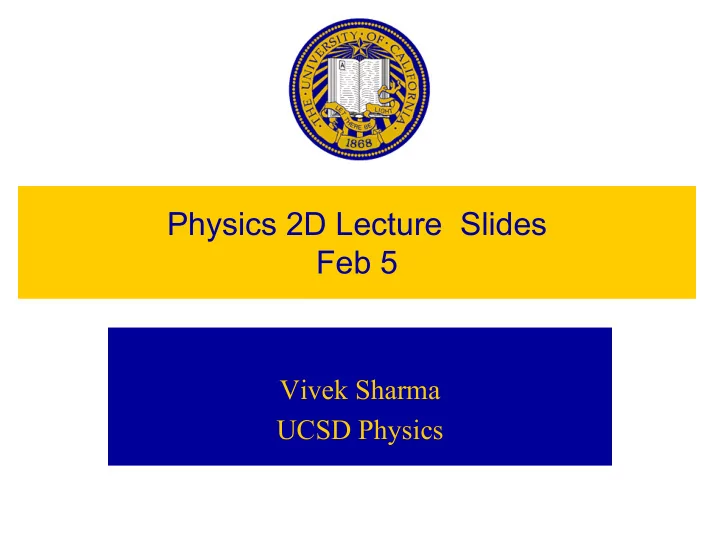

Physics 2D Lecture Slides Feb 5 Vivek Sharma UCSD Physics
Continuous & discrete spectra of Elements
Visible Spectrum of Sun Through a Prism
Emission & Absorption Line Spectra of Elements
Kirchhoff’ Experiment : “D” Lines in Na D lines darken noticeably when Sodium vapor introduced Between slit and prism
Emission & Absorption Line Spectrum of Elements •Emission line appear dark because of photographic exposure Absorption spectrum of Na While light passed thru Na vapor is absorbed at specific λ
Spectral Observations : series of lines with a pattern • Empirical observation (by trial & error) • All these series can be summarized in a simple formula 1 1 = > = R , n n n , 1,2,3,4.. f i i λ − 2 2 n n f i Fitting to spectral line series da ta × − 7 1 R=1 .09737 10 m How does one explain this ?
Rutherford Atom & Classical Physics
Atom: The Classical disaster
Bohr’s Bold Model of Atom: Semi Quantum/Classical -e 1. Electron in circular orbit m e around proton with vel=v 2. Only stationary orbits allowed . Electron does not F V radiate when in these stable +e (stationary) orbits 3. Orbits quantized: r M e v r = n h/2 π (n=1,2,3…) – 4. Radiation emitted when electron “jumps” from a stable orbit of higher energy 2 e � stable orbit of lower = − U r ( ) k r energy E f -E i = hf =hc/ λ 5. Energy change quantized 1 = 2 KE m v • f = frequency of radiation e 2
Reduced Mass of 2-body system -e m e +Ze F V + r CM +e r m e -e Both Nucleus & e - revolve around their common center of mass (CM) • Such a system is equivalent to single particle of “reduced mass” µ that • m e revolves around position of Nucleus at a distance of (e - -N) separation µ= ( m e M)/(m e +M), when M>>m, µ= m (Hydrogen atom) Ν ot so when calculating Muon (m µ = 207 m e ) or equal mass charges rotating around each other (similar to what you saw in gravitation)
Allowed Energy Levels & Orbit Radii in Bohr Model Radius of Electron Orbit : 2 1 e − 2 E=KE+U = m v k r = e mvr n � 2 Force Equality for Stable Orbit n � ⇒ = v , ⇒ Coulomb attraction = CP Force mr 2 1 ke 2 2 m v e = 2 substitute in KE= 2 m v = k r e e 2 r 2 r 2 2 n � 2 2 m v e ⇒ = = ∞ r , n 1 ,2 ,.... = = ⇒ KE e k n 2 mk e 2 2 r = ⇒ n 1 B ohr Radius a 2 e 0 Total Energy E = KE+U= - k 2 2 � 1 2 r − = = × 10 a 0.529 10 m 0 2 ⇒ mk e Negative E Bound sy stem = = ∞ 2 In ge neral r n a n ; 1 ,2,... . T h i s much energy must be added to n 0 Quantized orbits of rotat io n the system to break up the bound atom
Energy Level Diagram and Atomic Transitions − 2 ke = + = E K U n 2 r = 2 since r a n , n =quantum number n 0 − 2 ke 13.6 = = − = ∞ E eV , n 1, 2, 3.. n 2 2 2 a n n 0 → Interstate transition: n n i f ∆ = = − E h f E E i f − 2 ke 1 1 = − 2 2 2 a n n 0 i f 2 ke 1 1 = − f 2 2 2 ha n n 0 f i 2 1 f ke 1 1 = = − λ 2 2 c 2 hca n n 0 f i 1 1 − = R 2 2 n n f i
Hydrogen Spectrum: as explained by Bohr 2 2 ke Z = − E n 2 2 a n 0 Bohr’s “R” Same as the Rydberg Constant derived emperically from Spectral series
Another Look at the Energy levels 2 2 ke Z = − E n 2 2 a n 0
Bohr’s Atom: Emission & Absorption Spectra
Some Notes About Bohr Like Atoms • Ground state of Hydrogen atom (n=1) E 0 = -13.6 eV • Method for calculating energy levels etc applies to all Hydrogen- like atoms � -1e around +Ze – Examples : He + , Li ++ • Energy levels would be different if replace electron with Muons • Bohr’s method can be applied in general to all systems under a central force (e.g. gravitational instead of Coulombic) Q Q M M = → If change U r ( ) k 1 2 G 1 2 r r Changes every thing: E, r , f etc "Importance of constants in your life"
Atomic Excitation by Electrons: Franck-Hertz Expt
Atomic Excitation by Electrons: Franck-Hertz Expt
Recommend
More recommend